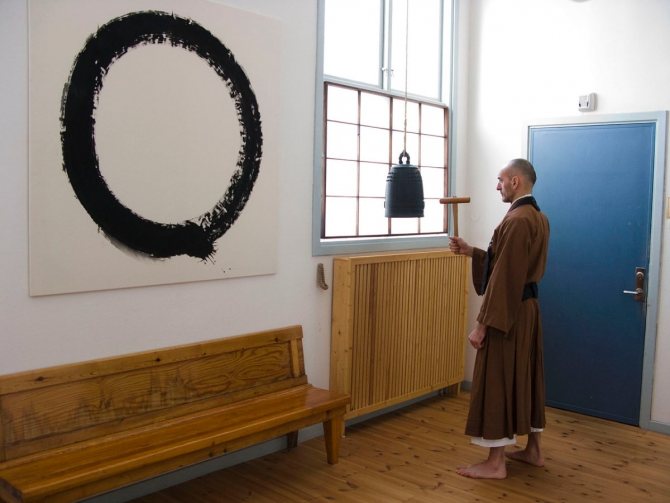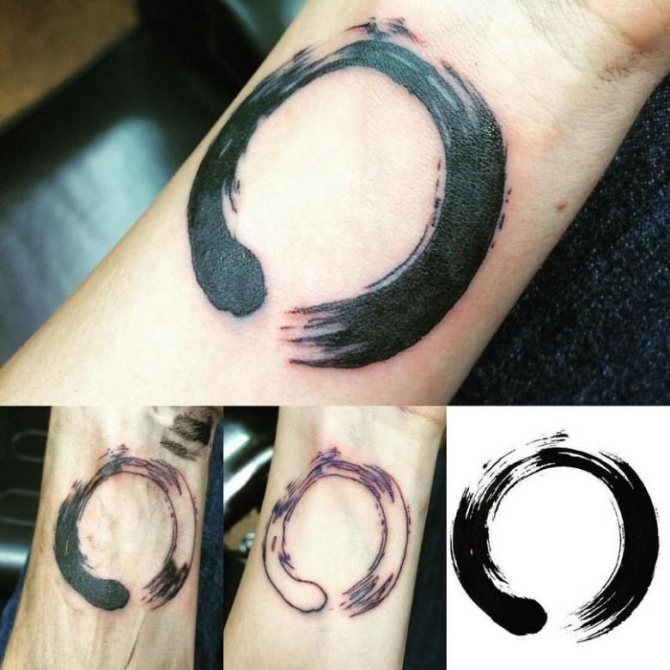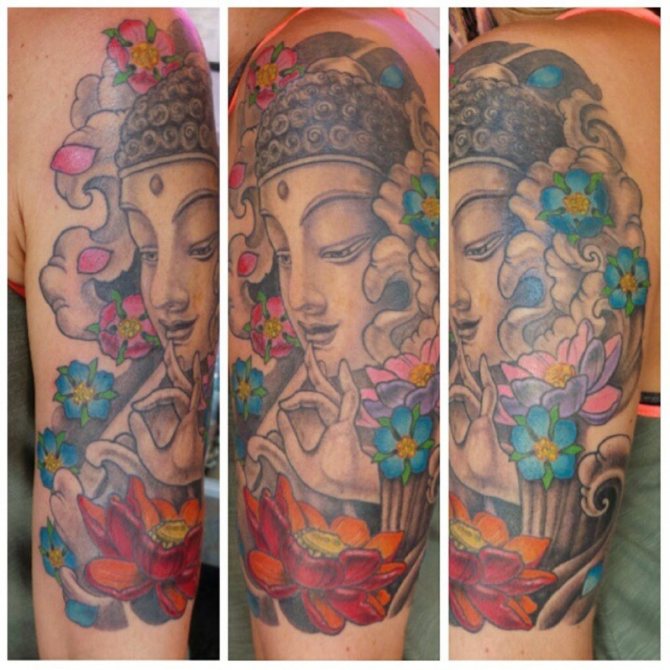We propose to understand the meaning of the tattoo with the image of Zen. This is how it is customary to call one of the key concepts in Buddhism. Its essence is to mystically observe the inner and outer worlds of the observer. The main goal of this process is enlightenment.
The word "Zen" is of Japanese origin. It has its roots in the ancient Indian "dhyana," which means "immersion, deep contemplation. The main thing that the followers of Zen strive for is enlightenment. It can be attained by anyone through meditation as well as self-immersion. In modern Western culture the word means detachment from everyday problems and immersion into spirituality. Zen symbolism is commonly associated with Zen Buddhism as well as Japanese calligraphy. It refers to those moments when the mind is completely free of any thoughts or ideas. Thus, the true essence of man is free to do whatever he wants. It must be said that this image is one of those whose emergence is recorded in history. In 1707, the monk Hakuin saw a village calligrapher doing masterful work. He was so taken aback by the talent that he even decided to burn his brushes, as he considered his own work not very worthy.
The enso is generally considered to be the most interesting Zen drawing of the master. It is a kind of symbol of integrity and completeness. Such a drawing may be in the form of either a closed or an open circle. In the first case, the circle is a symbol of continuous rebirths, and the space within it represents enlightenment and liberation. The second may indicate something more significant and inseparable from the outside world.
The teachings of Zen: the direction of which religious philosophy?

The teachings of Zen: a branch of religious philosophy called Buddhism
Zen is an inaccurate name for a religion that has undergone changes already in our day, and it is not really a religion. At first this philosophy was called Zen. Translated from Japanese, Zen means: 禅; Sanskrit ध्यान dhyana, Kit. 禪 chan.. The word translates as. "think properly", "to focus inwardly on something.".
The teachings of Zen are the orientation of religious philosophy from the Buddha. It follows the Mahayana legacy that originated in the Celestial Empire and has since become known throughout the Far East (Vietnam, Korea, Japan). But followers believe that Zen is a philosophy of Japanese Buddhism, which was brought to this country from China in the twelfth century.
Men's preferences
In favor of the sign make the choice of strong unconventional natures, seeking for productive action. For them it is:
- Integrity;
- filled emptiness;
- rebirth in a good direction;
- poise;
- Universe.
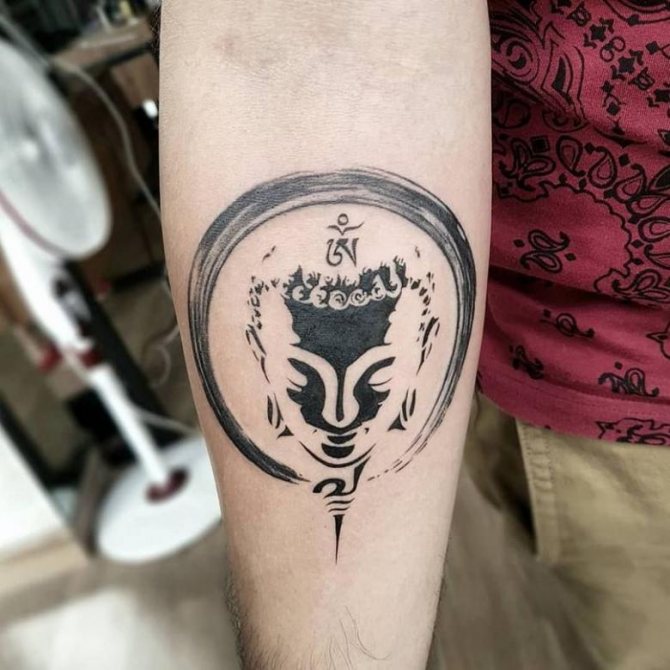

Possessors are passionate about achieving enlightenment, perfection, and try to live in the moment. The variation with the black circle associated with Malevich's square is popular. Everyone sees something personal in it.


What is Zen Buddhism: definition, basic ideas, essence, rules, principles, philosophy


Zen Buddhism
After the 12th century, the traditions of Japanese and Chinese Zen found their place in life separately from each other, but until today they have preserved their unity and acquired their characteristics. Japanese Zen is taught at several schools - Rinzai (Linji in Chinese), Soto (Caodong in Chinese) and Obaku (Huangbo in Chinese).
- The word Zen has its roots in the Sanskrit-Palian era "dhyana/jhana".
- The Chinese used to pronounce "Zen" as "Chan.
- The Japanese pronounced "Zen" correctly, which is how the name and sound of the word has come down to this day.
- Now Zen is a popular philosophy and practice of Buddhist orientation.
- This philosophy is taught in Zen schools. There is also another official name for this religion - "Heart of Buddha" or "Mind of Buddha. Both variants are considered correct.
The basic ideas and the essence of the doctrine of Zen are as follows:
- Zen cannot be learned.. Teachers only suggest ways in which a follower can attain enlightenment.
- It is worth noting that the masters of this religion do not use "attain enlightenment" in their vocabulary. The correct phrase would be: "to enlighten and see one's own self." to change oneself for the better.
- It is not possible to point out one path for everyone, as each person is different - with their own ideas about life attitudes, experiences, and living conditions. A person must find his or her own entrance without substituting consciousness with special performance of practical activities or following ideas.
- Human language, images and words are meaningless. It is impossible to achieve insight through them. Such a state will become available through traditional Zen methodological instructions and even stimuli from the outside - a sharp cry, a hard blow and so on.
The principles of Zen Buddhism lie in four truths:
- Life is suffering .. When one understands this, one will take everything for granted. People are imperfect and the world is not perfect. If you want to achieve Zen, you have to accept it. Buddha recognized this and accepted it. He understood that one has to go through many things during life: suffering, illness, deprivation, unpleasant situations, grief, pain.
The next 3 truths are about desire:
- Desire for attachment. The Buddha stated that the main cause of psycho-emotional disorder is attachment to one's desires. If we can't have something, life isn't good for us. But we shouldn't be angry and irritated about it; we should accept it.
- The end of suffering. If you get rid of attachment to desires and free yourself from anguish, the mind is cleared of anxiety and restlessness. This state of mind is called nirvana in Sanskrit.
- Walking the path to the end of suffering. Nirvana is achieved simply by leading a measured life. Follow the Eightfold Path, which is self-improvement in one's desires.
The teacher must see his own nature in order to teach it to his students. In addition, he must see the real state of the student. Only in this way can the master give the right advice and guidance to the awakening impulse.
The philosophy of Zen Buddhism consists of the doctrine of the three poisons. It is because of these that all troubles, torments and delusions appear in a person's life. Such evils include the following:
- Man does not understand his nature. - The mind is clouded, there is a constant restless inner state and even manifested dullness.
- There is an aversion to specific situations, things - A perception of something as an independent evil, a rigid outlook on life.
- Excessive attachment - to something pleasant, clinging to unnecessary things in this life.
Therefore, the rules of Zen Buddhism state:
- Quiet your mind.. Be calmer, don't be nervous about nothing, so that life can flow peacefully and smoothly.
- Free yourself from rigid views. Understand that man creates evil around himself with his own hands. If we look at life differently, everything around us will change.
- Free yourself from attachment.. Understand that good things come in small increments, otherwise life will lose its taste and bright colors. There should not be an unquenchable thirst for pleasures. All good things in moderation.
Pupils are given different advice, but such that they are understandable to the individual. For example:
- Engage in meditation to quiet and calm your mind. At the same time, try and follow all of the teacher's advice.
- Don't try to achieve tranquility and enlightenment, but to let go of everything that happens around you.
Followers of Zen practice a lot of meditation in a sitting position and do simple work. It may be growing some crops in the mountains or doing some simple cleaning. The main goal is to quiet your mind and unify your thoughts. Then the self-talk stops, the clouding of the mind disappears (Zen masters believe that modern people all have clouding of the mind) and the restless state stabilizes. After enlightenment it is easier to see one's natural self.
Japanese and Chinese Zen: is it the same thing?


Japanese or Chinese Zen
Japanese and Chinese Zen are the same thing, but with their own distinctive characteristics.
Chan Buddhism is what the Chinese call the Zen religion.. Many followers at the beginning of their journey cannot understand Chan Buddhism. It seems to be something unattainable, irrational and even mystical. But Zen insight is endowed with universal characteristics.
Zen's influence on Japan's cultural heritage makes us recognize this school as important and relevant in the study of the ideas of Zen Buddhism. It helps to reveal the ways in which philosophy and thought develop.
Psychological aspects, Zen Buddhism psychotherapy: practice


Zen Buddhism Psychotherapy.
To achieve satori a person should not just sit under the Bo tree and wait for an indulgence, enlightenment. A special relationship with a master is built and a specific system of procedures is carried out. Therefore, psychological aspects and psychotherapy of Zen Buddhism are important in order to free the personality for spiritual development.
- Many psychologists use the basics of Zen Buddhism in their practice.
- Especially good is the psychologist who is spirited with Zen ideas and is familiar with them firsthand.
- People are complex by nature. Some have obsessions with revenge on another person, others seek to get to the future faster or, on the contrary, are anxious about what may happen, and others are consumed by their past.
- A person may himself repeat actions that cause him trouble, but subconsciously and verbally, he wants to break out of this circle.
Zen psychology shows that all these addictions and fixations interfere with living and experiencing the present. The true and correct Zen path will lead to enlightenment and the right awareness of human existence.
Practice
In practical terms, Zen is meditation, immersion in a special state of contemplation. A variety of tools can be used for this - everything is determined by the practice of each individual, so quite non-standard ways of achieving enlightenment are often used. These can include shouting out a teacher, laughing or hitting with a stick, practicing martial arts, and physical labor.
According to Zen teaching, the best practice is monotonous work, which should be done not for the sake of achieving some end result, but for the sake of the work itself.


A clear example of this approach is given in one of the legends of a famous Zen master, who defined washing dishes in ordinary life as striving to make them clean, and the same action in the philosophical sense as self-sufficient, suggesting that his students wash dishes only for the sake of the action itself.
Another important philosophical practice is the koan. This is the name given to the logical exercise of solving a paradoxical or absurd problem. It cannot be comprehended by the "ordinary" (unawakened) intellect, but after spending enough time on contemplating it, one can once catch the feeling of understanding, i.e. reach the desired state instantly, in one moment, most often unexpectedly - without any background to it.
For example, one of the classic koans is the search for the "one palm clap," that is, the "silent sound.
Zen Buddhism as a philosophy and art of life: examples
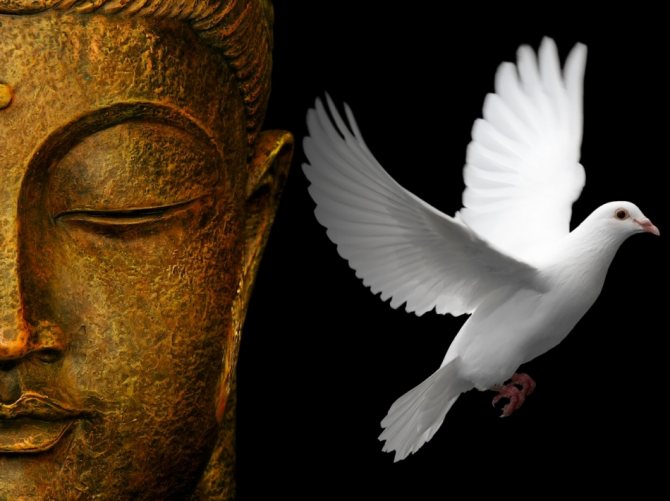

Zen Buddhism - philosophy and art of life
The main goal of Zen Buddhism is to achieve enlightenment or satori. For Europeans such a philosophy and art of life as Zen is something unattainable. But there is nothing supernatural about this teaching. These are ordinary skills that have been honed to perfection by Zen masters.
Here are examples of this art of life:
A preceptor speaks to his disciple:
- Are you becoming established in the truth? - Yes, master. - What do you do for your upbringing? - I eat when I am hungry and go to bed when I am tired. - But that's what every man does. So it turns out that you don't educate yourself, you live like every other person? - No. - Why not? - Because when they eat, they are not busy eating, but distracted by talking and other extraneous things; when they rest, they don't sink into sleep at all, but they see a lot of dreams and even experience emotions in their sleep. Therefore, they are not like me.
In explaining this example-parable, ordinary people experience constant fear and mixed feelings of insecurity, and they live in an illusionary world rather than a real one. People think they are tasting and feeling something, rather than actually experiencing all the emotions.
Another example of Zen philosophy is revealed by another parable:
The master of this teaching tells of himself: "When I did not yet know Zen, rivers were rivers to me and mountains were mountains. With the first knowledge of Zen, rivers were no longer rivers, and mountains were no longer mountains. When I fully understood the teachings and became a teacher myself, the rivers became rivers again and the mountains became mountains.".
This is evidence that after enlightenment, what is here and now begins to be perceived differently. We mistake shadows for plausible things, and being in the dark at this time, it is impossible to know the light. For Zen, it is important that one know oneself from within, not with one's mind. Zen must penetrate to the depths of the human soul and being.
How to monetize your channel?
Many beginning bloggers are attracted by the fact that Yandex Zen is a real opportunity to earn money for their publications. The service exposes the following conditions for connecting monetization:
- The channel must reach 7 thousand full reads of materials in a week.
- The duration of one reading should be at least 40 seconds.
If the channel meets the conditions set, ZEN offers several options to earn money: advertising network of Yandex and direct selling ads ADFOX, inserting their creations or forms for the collection of money. The difference in the two options is as follows: in the first case, the service itself is looking for advertisers, places banners and pays taxes. In the second - you decide what and where to place.


Accordingly, the first method is simpler. Service pays from 40 to 180 rubles per publication (not less than 40 seconds). Earned money is withdrawn to Yandex Wallet or PayPall.


What does it mean to know Zen, the state of Zen, inner Zen?


The state of Zen, inner Zen
Among people you may hear: "Cognizant of Zen.". What does it mean to know Zen, the state of Zen, inner Zen? It means: "a state of constant meditation" и "an absolute unperturbed mind.". But if a person talks about it and even claims to know what Zen is, he lives deceived. To know the essence of Zen is given only to a chosen people and the teachings of this philosophy are constructed so that a person will not talk about himself in such a way.
The state of Zen is tranquility from within, a bright mind and soul. Zen within a person is equanimity. A person who has learned Zen cannot be thrown off balance. In addition, he can help his opponent find inner peace on his own.
How to reach the state of Zen?


Only a chosen few can reach the state of Zen
Entering the state of Zen is not a game at all. The follower focuses on his or her ordinary life position. To reach the state of Zen, everything around you must be in accordance.
- Harmony in everything is the most important thing.
- You are confident and you know you can achieve it.
- All the problems around you disappearA special energy fills the world around you. Something perfect appears, which helps to solve problems.
- Your skill corresponds to the set tasks. - Everything turns out harmoniously. For people who are familiar with sports, such a moment is called "being in the zone". In science, such a process is called "flow."
- You should feel like you're in a dream .. In the "flow," time and consciousness are lost. It is as if you dissolve into everything around you. It's easier for a child to enter the state of Zen, but harder for adults. They understand the definition of time. But it's harder for a young person with his unstable psyche to break out back into the transience, so the Zen state can be dangerous for a child.
When you immerse yourself in the state of Zen, you will realize that you don't need to plan anything. It is the habit of outlining different plans that "stifles" creativity in all of us. There is nothing more awakening and toning than to be in the "flow," specially created by your mind's "zone" or "white moment.
Promotion of the channel in Yandex.Zen with the help of third-party resources
In order to promote your channel and bring it to monetization, you will need to spend a lot of effort. Partially facilitate this task are capable of third-party platforms to promote channels in Yandex.Zen.
Zenovik
Zenovik is suitable for maintaining several channels in Zen. It analyzes competitors' content and selects themes for each promoted blog based on the information obtained. You can also use it to set up delayed posting of articles, view ratings of popular authors and most-read materials, and perform a number of other tasks that allow you to effectively develop your own project.
You can't buy a separate service in Zenovik. You need to buy one of the available tariff plans:
- Beginner (490 rubles/month) - for three blogs.
- Monk (890 rubles/month) - for 4-10 projects.
- Enlightened (1890 rubles/month) - for 11-30 blogs.
Additional information! If you don't plan to create more than one channel, you can choose "Beginner" rate.
What is Zen meditation?
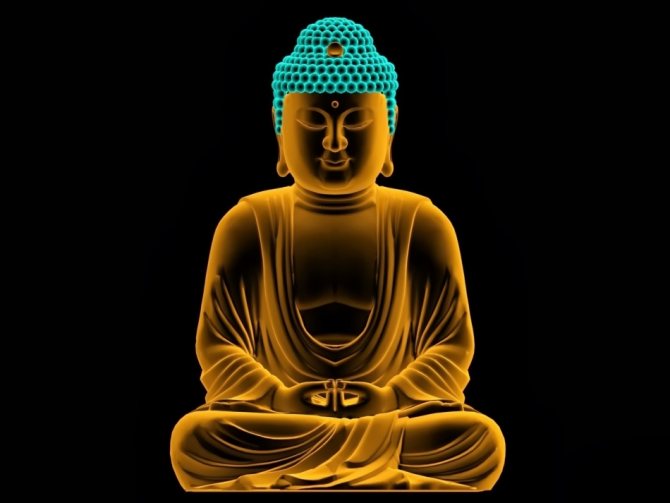

Zen meditation
Zen meditation is a meditative relaxation technique from the Buddha. It is the most popular technique in the world - it is the heart of Buddhist teaching. The benefits of Zen meditation include the following:
- Learning to concentrate well
- Opportunity for self-knowledge
- Gain peace and joy
- Improvement of health
- Gain willpower
- Increase in internal energy
Warning: If you do it right, there will be an emotional storm inside you. You may experience this state after a few days or weeks of practice. Your repressed emotions will rise up - into consciousness. At this point, it's important not to fight them, but to give them a chance to get out. After that, peacefulness, mental clarity and joy will come.
Zen meditation technique:


Zen Meditation.
There are two basic Zen meditation techniques: intermediate and extended:


Two basic Zen meditation techniques
Tip: Don't try to become artificially aware of the mystery of Zen. Do not get hung up on the inhalation and the exhalation. The most important things will happen in between: the mysteries of the universe will unfold, you will know yourself and so on. Just meditate properly and everything will happen naturally.
Types of Content
For a registered user, the service offers to publish the following types of materials:
- Article. This is a text format for presenting information with the ability to insert photos, videos, gifs, and banners. To write an article in the channel is simple enough: click on the plus sign in the green box of the cabinet and select the article item in the drop-down list. You will face the following nuances: ZEN Yandex is a meager editor, not very handy and hangs up. But there is no other yet.
- Narrative. The service's own work is reminiscent of the storiez in Instagram. One difference is that the narratives do not disappear from the feed. Accordingly, Zen cherishes its "creation" in every way and tries to fix it in the users' minds. For example, the best narratives are posted on a special page of the service. This increases the reach of the publication many times over. Find the narrative editor in the same place as the articles (the plus sign in the green square). The maximum number of slides is 12. You can insert text, pictures, videos or gifs on the screens, as well as posting links to the site, products.
- Video. The duration of the video is no more than 2 minutes. You can watch directly in the feed. Copying from YouTube, VK and other channels is allowed.


Zen has quite serious requirements for publications.
What is the difference between Zen Buddhism and Buddhism: the difference, distinction, features
Regarding the understanding of Zen Buddhism, it is worth noting that if one tries to understand, it will not be Zen Buddhism. One must comprehend reality as it is. If we talk about the differences between Zen Buddhism and Buddhism, there is no difference, because this practice is Buddhism. All practices of Buddhism are divided into:
- Samathi - Calming the mind and body, understanding peace and tranquility.
- Vipassana - Allows you to observe the emergence of mind phenomena. One discovers something new for oneself in feelings, thoughts and emotions.
All practices of Buddhism help the mind to get rid of suffering, to free itself from wrong views, to nurture the right worldview. Just Zen helps to acquire the important elements of the right way of thinking and living, eliminating the destruction of the mind. It is not necessary to follow rules, it is important to understand the world order. In Buddhist practice there are no rules, assumptions, hypotheses. If a person learns to comprehend Zen, he will get rid of delusions and live in peace and tranquility.
Symbols of Zen Buddhism and their meaning: photo
In Buddhism, as in Zen Buddhism, there are many different symbols. But in Zen the most important and significant is considered Enso - The circle of enlightenment and freedom. This symbol of Zen Buddhism do in the form of tattoos, drawing on the walls of homes, especially in China and Japan, and decorate interiors with its image.
Enso means enlightenment, strength, grace, emptiness, the universe. The circle itself is the continuous karmic rebirths, and the inner space is a sign of liberation from the burdens of life.
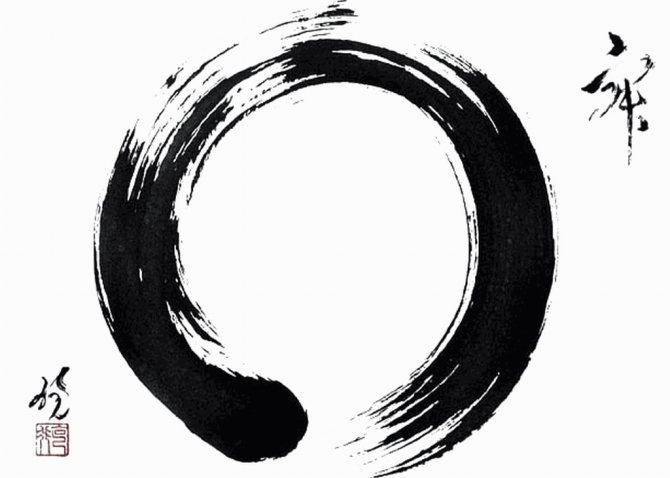

The symbol of Zen Buddhism
This symbol may be depicted with a lotus flower inside as evidence that one has become whiter, more majestic and inseparable from nature - peaceful and tranquil.
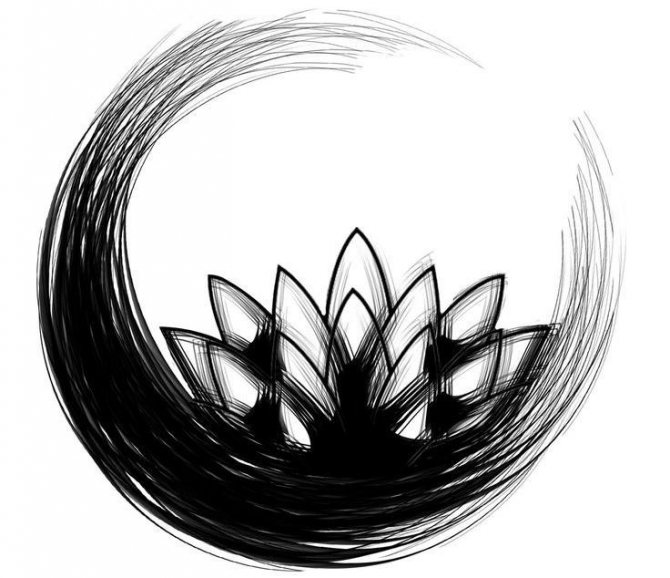

Zen symbols with the lotus
In fact, in the circle. Enso You can depict symbols or even Buddha. It would still have the right Zen meaning of enlightenment, purification and peace.
Spectacular Buddhist sign - Enso tattoo
For Zen is a sacred symbolism, acting as a mark of the original Buddha, the face of reality.


In the image reveals the artist himself, pure and whole spirit, only such a person is able to create a true masterpiece.


Sages spend many hours in this activity and draw the image daily, which appears as a kind of diary of life, reflecting the growth of the personality. Teachers tend to use a sheet of paper, earth, air.


It was born around the eighth century. Hakuin, a former monk watched a village calligrapher work and was struck to the core, immediately destroying his own brushes, thinking that his painting did not reflect the inner essence of objects.


The outlines are a visual representation of the Heart Sutra, which regards emptiness and form as mutually substitutable concepts.


The Koans of Zen Buddhism: Examples
The koans of Zen Buddhism are small narratives with questions and dialogues. They may have no logic, but will be understandable to a person who wants to know Zen. The purpose of the koan is to create a psychological impulse for the student to understand and achieve enlightenment. It is a kind of parable, but the koan need not be translated or understood, it serves to understand true reality.
Here are examples of koans:


Koans of Zen Buddhism: Examples


The Koan of Zen Buddhism: an example


The Koan of Zen Buddhism
Don't try to understand Zen Buddhism. It has to be inside you, it is your true essence. Practice self-discipline, know the joy of existence, believe, accept, and then you can comprehend Zen and accept it into yourself.
Additional details.
The presence within a forest, a tree, changes the meaning. It is a way to nature, a desire to merge with it, finding purity. The wearer is contemptuous of worldliness, wishing to comprehend the essence of what is happening, he contemplates it calmly. The tattoo marks him as a lover of solitude.


When the center of the lotus is applied, it is an emblem of female essence, rebirth, correction of past mistakes. Also, the flower means life and death in inseparable unity, a thirst for eternal existence, bestowing happiness and peace on the bearer.


A variety of additive elements are available in the studio:
- The dot in the middle recalls the wheel or the dial of the clock, stating the transience of existence. The master says by this that he makes decisions in a balanced way, taking responsibility for his behavior.
- The guise of a monk or Buddha assists in gaining the wisdom to live according to universal laws and to channel aggression in a positive direction.
- The incomplete circle with a dragon or warrior in red is a metaphor for a fighting spirit, fortitude in a rivalry with the enemy.
- In the workshop you may be offered natural, cosmic landscapes, a Celtic cross, a religious theme.


The picture is accompanied by phrases more often in Latin - the life-affirming motto of the person, bringing success in achievements and giving the necessary victorious energy.


For men the circular shape is the embodiment of the sun, for women - the full moon. Alchemists circle is in demand - a mystical image with different components.



